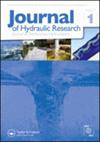自由表面流动界面湍流处理模型的评估
IF 1.7
3区 工程技术
Q3 ENGINEERING, CIVIL
引用次数: 0
摘要
复杂自由表面流动的建模具有挑战性,因为界面的流动性和可变形性以及空气夹带特性受到湍流的高度影响。在Reynolds平均Navier-Stokes (RANS)模型和流体体积(VOF)方法的框架下,空气-水界面处的湍流量往往被高估。本文研究了基于简单梯度扩散假设(SGDH)的浮力修正模型和Egorov湍流阻尼模型等界面湍流处理方法。此外,由于标准k-ε湍流模型具有无条件不稳定的特点,采用稳定的k-ε湍流模型进行比较。比较和讨论了在加气推覆体和不加气推覆体情况下,分层流动和自由溢流堰在界面附近采用不同的界面湍流处理方法的湍流衰减性能。根据实验数据和分析模型验证了不同流动条件下的湍流量和自由表面轮廓。结果表明,对于自由表面波,与标准k-ε模型相比,SGDH模型和湍流阻尼模型在湍流产生方面都有较强的改善。SGDH模型增加了不稳定分层中的湍流动能(TKE),导致部分分散和分离流动的非物理行为。本文章由计算机程序翻译,如有差异,请以英文原文为准。
Assessment of interfacial turbulence treatment models for free surface flows
The modelling of complex free surface flows is challenging due to the mobility and deformability of the interface and air entrainment characteristics, which are highly affected by turbulence. With the framework of Reynolds averaged Navier–Stokes (RANS) models and the volume of fluid (VOF) method, turbulence quantities at the air–water interface tend to be over-estimated. In this study, interfacial turbulence treatment methods including the buoyancy modification model based on the simple gradient diffusion hypothesis (SGDH) and Egorov’s turbulence damping model are investigated. Furthermore, due to the unconditionally unstable characteristics of the standard k-ε turbulence model, the stabilized k-ε turbulence model is applied as a comparison. The turbulence attenuation performance using different interfacial turbulence treatment methods in the vicinity of the interface is compared and discussed for stratified flows and free overflow weirs for aerated and non-aerated nappe scenarios. The turbulence quantities and free surface profile under different flow conditions are validated against experimental data and an analytical model. The results show that for free surface waves, both the SGDH model and the turbulence damping model give strong improvements in turbulence production compared with the standard k-ε model. The SGDH model augments the turbulence kinetic energy (TKE) in the unstable stratification, leading to unphysical behaviour for the partially dispersed and separated flow.
求助全文
通过发布文献求助,成功后即可免费获取论文全文。
去求助
来源期刊

Journal of Hydraulic Research
工程技术-工程:土木
CiteScore
4.90
自引率
4.30%
发文量
55
审稿时长
6.6 months
期刊介绍:
The Journal of Hydraulic Research (JHR) is the flagship journal of the International Association for Hydro-Environment Engineering and Research (IAHR). It publishes research papers in theoretical, experimental and computational hydraulics and fluid mechanics, particularly relating to rivers, lakes, estuaries, coasts, constructed waterways, and some internal flows such as pipe flows. To reflect current tendencies in water research, outcomes of interdisciplinary hydro-environment studies with a strong fluid mechanical component are especially invited. Although the preference is given to the fundamental issues, the papers focusing on important unconventional or emerging applications of broad interest are also welcome.
 求助内容:
求助内容: 应助结果提醒方式:
应助结果提醒方式:


